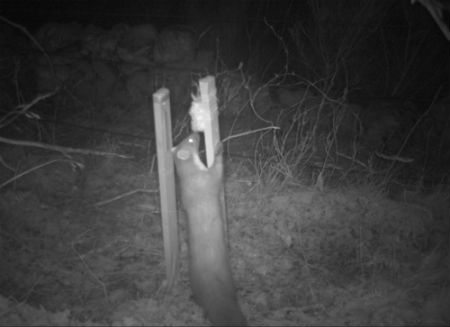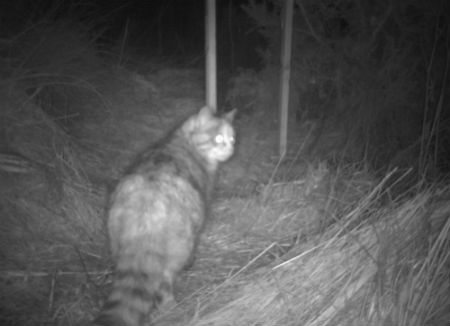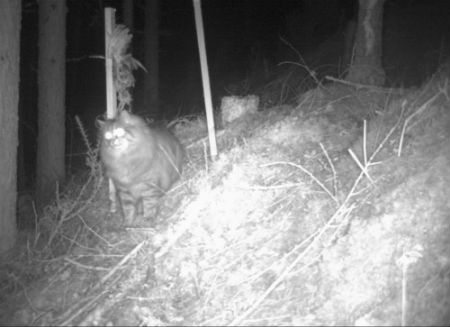We’re supporting Scottish Wildcat Action with their wildcat monitoring work by providing funding for camera traps; which are vital to identifying areas where wildcat populations are thriving or suffering. Without this important information, appropriate conservation efforts can’t be put into action.
Clare Hill volunteered to help Scottish Wildcat Action with winter surveys in search of the ever-elusive Scottish wildcat. Below she tells us more:
“Equipped with camera traps, wooden stakes, salmon oil and bait I set out to explore my nominated kilometer squares within the survey area to find the best locations to place camera stations. Having previous experience of camera trapping I followed tracks and trails and tried my best to think like a wildcat.
“Setting up the stations I (and trustee companion Charlie my dog) encountered rain, high winds, sleet, snow and the occasional beautifully crisp, sunny, blue-sky day. Snowfall gave me the advantage of being able to see tracks of deer, badger and most importantly cat! However, the cat prints I found could have easily been from a domestic cat as I wasn’t too far from residential homes and the prints didn’t seem to be much bigger than your average pet cat.
“I decided to place one of the stations close to cat prints with only one home in the nearby vicinity. I knocked on the door to the house to tell them all about the survey, Scottish Wildcat Action and most importantly to find out if they had a pet cat who could be the owner of the prints. My hopes were heightened upon hearing the news they don’t have a pet cat.
“With all of my trail-camera stations set up I looked forward to checking them fortnightly to see what wildlife photos they would yield. Eagar to check my first cameras I woke up early, whilst watching the tail end of the sunrise with my essential morning coffee. The first camera I checked yielded hundreds upon hundreds of pine marten photos! Although I knew Scottish highlands are one of the best places to see pine martens, after camera trapping for many years in Cheshire and Wales it was a surprise and such a joy to see so many photos of them.

“I had similar experiences checking the other bait stations finding photos of pine marten, badger, deer, stoat and buzzards. But in the first four weeks of my camera traps being live still no sign of any wildcats. So when going out on the third trip after six weeks of the cameras being live I had become convinced that, although the habitat was great for pine marten, I probably wasn’t going to find any cats. This made it even more of a shock when upon checking one of the cameras it had some cat photos!
“The photos showed a tabby cat with a fat and faintly-striped tail, but with more blotches than stripes and a white/light chest patch, my first thought was it will be an obvious low-scoring hybrid, or even possibly a domestic cat.

“It was great to see these cat photos justifying my reasons for where to place the trail camera and perhaps there was still hope for my other cameras to capture some cat photos. I was right in thinking so because other cameras I checked that week had cat photos too. One cat visited a station that had been very popular with pine marten previously. This cat was a tabby but with long hair making it seem like it has a mane of sorts, a very strange looking cat and with only one photo so far to judge it’s highly unlikely to be a possible wildcat. However, it’s still important to find hybrid wildcats for the next part of the project; to trap neuter vaccinate release (TNVR) feral domestic cats and obvious hybrids.

“The camera set up near cat prints in the snow also had a photo of a cat, although this white cat was obviously a domestic cat, and the clearly-visible collar means it will not be a target for TNVR.
“With my final camera checks nearly completed, I still had my fingers crossed to find possible wildcats. I decided to leave a camera running for an extra two weeks, in case a wildcat made an appearance. I’m pleased to say that my persistence was rewarded!
“Although this cat has not yet been ‘pelage scored’ (pelage is the fur, hair, or wool of a mammal). The scoring process is where certain coat or pelage characters are given a score based on how hybridized they are, which classifies the cat as Domestic, Hybrid, or Wildcat.
“The distinct stripes on the tail, presence of a dorsal stripe down the back, and stripy flanks and hindquarters, definitely suggest a possible wildcat or higher-scoring hybrid cat. The Project Officer for this area will now compare the videos and photos to other images found during the survey, to find out how many different individuals there were, and where they were found.
“The cameras and SD cards need to be collected from all the survey volunteers (79 cameras for Strathpeffer, and over 300 SD cards!) and then the data analysis can begin. The winter surveys will be repeated for five years to estimate wildcat population density for the area, and to help target conservation action, such as the ongoing TNVR schemes to help preserve Scottish wildcat genes.
“My volunteer experience has been thoroughly rewarding so far and I have signed up to help with education, community engagement and TNVR once the winter surveys for this year have concluded. It’s such an interesting project to be involved with and a huge undertaking to try and find out how many genetically viable Scottish wildcats actually remain in the wilds of Scotland.”
If you would like to find out more information about the work Scottish Wildcat Action are doing or if you think you have spotted a wildcat and would like to report a sighting, please visit the Scottish Wildcat Action website.